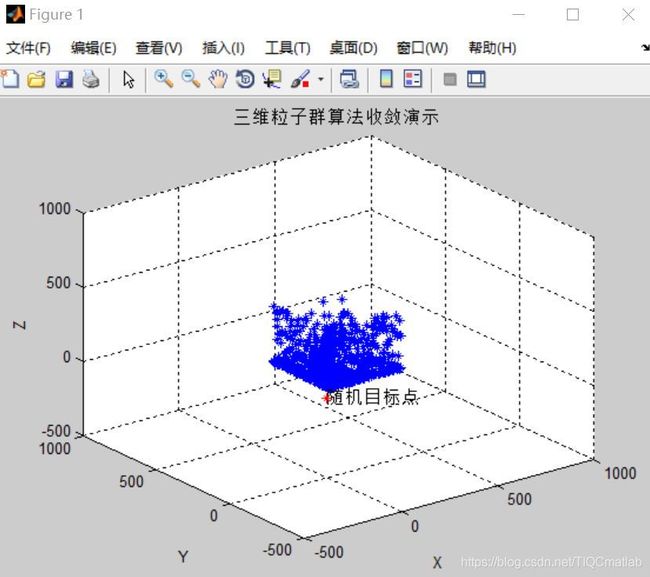【优化算法】基于matlab三维粒子群算法【含Matlab源码 902期】
一、简介
基于matlab三维粒子群算法
二、源代码
SR=1000;%搜索范围Searching range
RNS=1;%群体规模与搜索范围之比The ratio of the number of particles to the searching range
M=RNS*SR;%群体规模Members
W=0.5;%惯性权重Inertia weight
C1=5;%加速常数Accelerated constant
C2=5;%加速常数Accelerated constant
RVR=0.02;%最大速度与搜索范围之比The ratio of the maximum velocity to the searching range
RCS=0.01;%收敛区间与搜索范围之比The ratio of the convergent interval to the searching range
CI=RCS*SR;%收敛区间Convergent interval
PT=0.0000000000000000000000000000000000000000000000000000000000000000000000000000000000000000000000001;%暂停时间Pause time
RNPA=0.5;%正负半轴标度之比The ratio of the negative half axis to the positive half axis
x=SR*rand(1,M);
y=SR*rand(1,M);
z=SR*rand(1,M);
px=x;
py=y;
pz=z;%初始化个体历史最优解数据
vx=RVR*SR*rand(1,M);
vxmax=RVR*SR*(zeros(1,M)+1);
vy=RVR*SR*rand(1,M);
vymax=RVR*SR*(zeros(1,M)+1);
vz=RVR*SR*rand(1,M);
vzmax=RVR*SR*(zeros(1,M)+1);
ox=SR*rand*(zeros(1,M)+1);
oy=SR*rand*(zeros(1,M)+1);
oz=SR*rand*(zeros(1,M)+1);%随机生成谷地位置 以上为初始化过程
sx=abs(x-ox);
sy=abs(x-oy);
sz=abs(x-oz);%评估每个微粒的适应度
[r,c]=find(sx==min(min(sx)));
gx=x(r,c)*(zeros(1,M)+1);
[r,c]=find(sy==min(min(sy)));
gy=y(r,c)*(zeros(1,M)+1);
[r,c]=find(sz==min(min(sz)));
gz=z(r,c)*(zeros(1,M)+1);
while (max(max(sx))>CI)||(max(max(sy))>CI)||(max(max(sz))>CI)%确定结果收敛区间
ox=0.1*SR*rand*(zeros(1,M)+1);
oy=0.1*SR*rand*(zeros(1,M)+1);
oz=0.1*SR*rand*(zeros(1,M)+1);
plot3(ox,oy,oz,'r*');
title('三维粒子群算法收敛演示');
text(ox,oy,oz,'随机目标点');
xlabel('X'),
ylabel('Y'),
zlabel('Z');
axis([-RNPA*SR SR -RNPA*SR SR -RNPA*SR SR]);
grid on;
hold on;
plot3(x,y,z,'b*');
hold off;
pause(PT);
if max(max(sx))>CI
vx=W*vx+C1*rand*(px-x)+C2*rand*(gx-x);%根据算法方程给v一个改变量。因为区间长度较小,所以弱化微粒的自身惯性和自我认知能力,强化社会能力以尽快得到最优解
while max(max(vx))>RVR*SR||min(min(vx))<-RVR*SR
if max(max(vx))>RVR*SR
[r,c]=find(vx==max(max(vx)));
vx(r,c)=RVR*SR;
end
if min(min(vx))<-RVR*SR
[r,c]=find(vx==min(min(vx)));
vx(r,c)=-RVR*SR;
end%以上为限制v的大小,避免微粒飞过好解或陷入局部优值
end
x=x+vx;
for i=1:M
if abs(x(1,i)-ox(1,i))<sx(1,i)
px(1,i)=x(1,i);
end
end
sx=abs(x-ox);
[r,c]=find(sx==min(min(sx)));
gx=x(r,c)*(zeros(1,M)+1);
end
if max(max(sy))>CI
vy=W*vy+C1*rand*(py-y)+C2*rand*(gy-y);
while max(max(vy))>RVR*SR||min(min(vy))<-RVR*SR
if max(max(vy))>RVR*SR
[r,c]=find(vy==max(max(vy)));
vy(r,c)=RVR*SR;
end
if min(min(vy))<-RVR*SR
[r,c]=find(vy==min(min(vy)));
vy(r,c)=-RVR*SR;
end%以上为限制v的大小,避免微粒飞过好解或陷入局部优值
end
y=y+vy;
for i=1:M
if abs(y(1,i)-oy(1,i))<sy(1,i)
py(1,i)=y(1,i);
end
end
sy=abs(y-oy);
[r,c]=find(sy==min(min(sy)));
gy=y(r,c)*(zeros(1,M)+1);
end
if max(max(sz))>CI
vz=W*vz+C1*rand*(pz-z)+C2*rand*(gz-z);
while max(max(vz))>RVR*SR||min(min(vz))<-RVR*SR
if max(max(vz))>RVR*SR
[r,c]=find(vz==max(max(vz)));
vz(r,c)=RVR*SR;
end
if min(min(vz))<-RVR*SR
[r,c]=find(vz==min(min(vz)));
vz(r,c)=-RVR*SR;
end%以上为限制v的大小,避免微粒飞过好解或陷入局部优值
end
三、运行结果
四、备注
版本:2014a

